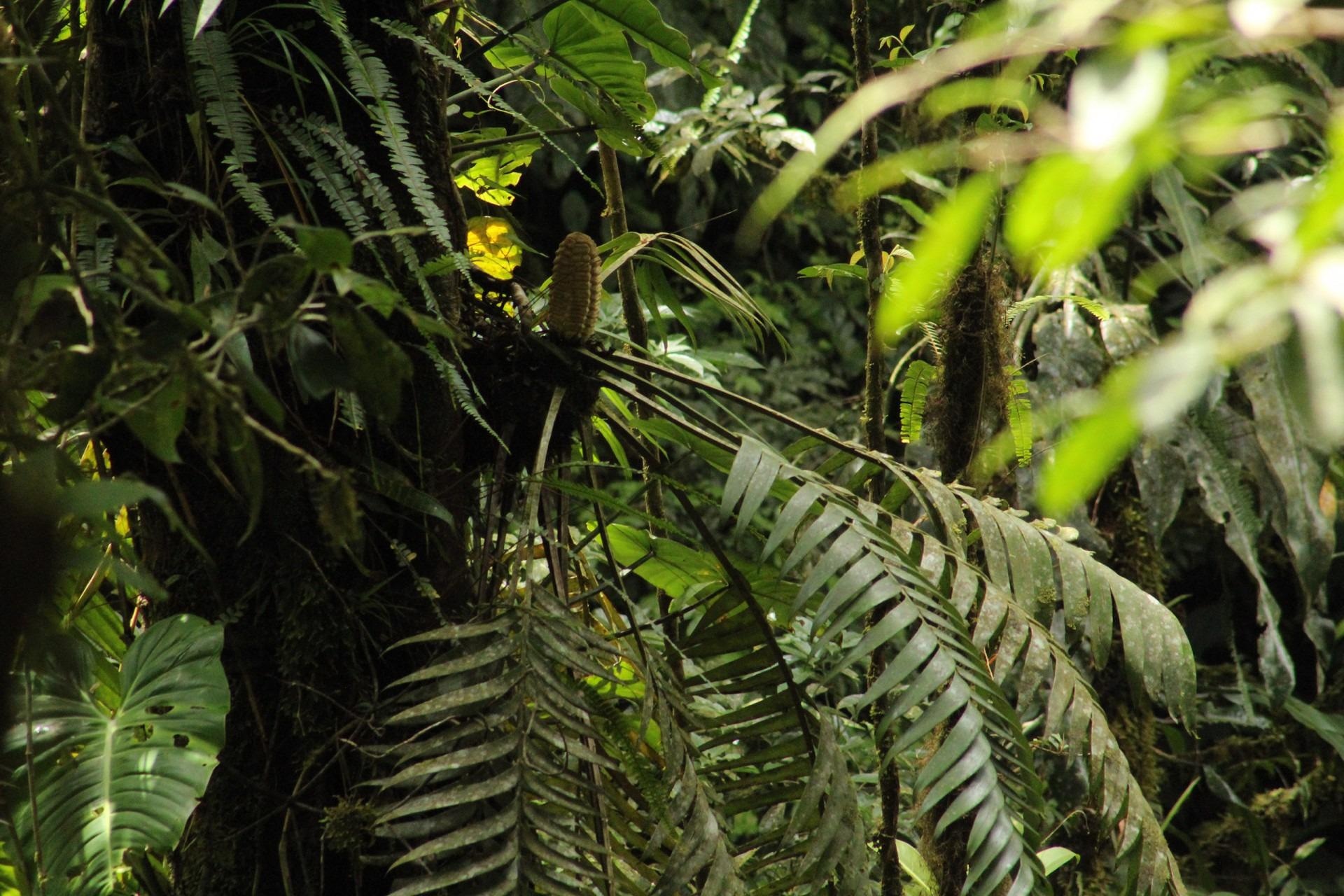For biologists performing fieldwork, sleeping in a car may be necessary. In the year 2020, a group of young researchers slept in their car for two nights in the highlands of western Panama. The Researcher’s car broke down at El Copé, in the province of Coclé, and they had to wait for a tow truck the second time. At the very least, a local woman felt sympathy for them and provided fried plantains and coffee.
 Zamia pseudoparasitica is the only species in its genus that grows on other trees, but little is known about how it persists in the canopy. Image Credit: Pedro Luis Castillo, Smithsonian Tropical Research Institute.
Zamia pseudoparasitica is the only species in its genus that grows on other trees, but little is known about how it persists in the canopy. Image Credit: Pedro Luis Castillo, Smithsonian Tropical Research Institute.
The study that resulted from those experiences was published in the Journal Ecology and Evolution a few years and a pandemic later, offering information about the natural history of a rare plant that only lives in Panama.
Zamia pseudoparasitica is a rare plant found exclusively in western Panama’s montane cloud forests. It is a cycad, a type of plant that looks like a palm tree and produces cones. Zamia is a genus that first appeared 68.3 million years ago when dinosaurs still roamed the earth.
The most unique aspect of this species is that it is the world’s only epiphytic Zamia: it does not grow on the ground, instead clinging to tree branches and trunks with its roots, which are often 7-20 meters above the ground.
A fortuitous research group organized to begin uncovering the puzzle of how it survives in the canopy. Claudio Monteza, a doctoral student at the Max Planck Institute for Animal Behavior and a visiting scientist at the Smithsonian Tropical Research Institute (STRI), and Lilisbeth Rodrguez, a Senacyt-STRI intern and biologist, met one day at the Smithsonian research station on Barro Colorado Island in the Panama Canal.
Lilisbeth informed Monteza about the Z. pseudoparasitica study she was working on alongside Juan Carlos Villarreal, a biologist from Laval University in Canada, and Kristin Saltonstall, an STRI staff scientist in Panama.
My goal was to collect samples from different species of Zamias in the country. These samples would later be analyzed in the laboratory to find out what species of fungi and bacteria grow inside their leaves.”
Lilisbeth Rodrguez, Senacyt-STRI Intern and Biologist, Smithsonian Tropical Research Institute
Juan Carlos Villarreal, Lilisbeth’s supervisor, told her that no one understood how the seeds of this plant got around: it was still a mystery. But, knowing Claudio’s work with video traps to investigate animal behavior and Lilisbeth’s expertise in climbing trees as part of a project, Lilisbeth wanted to borrow some traps. Lilisbeth intended to put them in the trees high up to see what kinds of animals were associated with the Zamia.
Claudio, as well as Pedro Luis Castillo, a research assistant at STRI, and Edgar Toribio, a Santa Fe tour guide, joined the experiment. The video traps were installed on trees in three protected regions where Z. pseudoparasitica grows: the Palo Seco Protected Forestry, the Santa Fe National Park, and the Omar Torrijos Herrera National Park in El Copé, at the end of 2019. Researchers acquired the video traps in March, just before a required pandemic quarantine began.
The photographs might explain why Zamia pseudoparasitica disperses in trees rather than on the ground like many other Zamia species. While seven distinct mammals visited the branch where Z. pseudoparasitica was growing, some paid little interest to the plant, while others, like capuchin monkeys, opossums, and kinkajous, examined the cones, licked them, but did not collect the seeds.
Only the northern olingo (Bassaricyon gabbii), a nocturnal tree-dwelling animal that feeds mostly on fruit and is active in the canopy, was seen at all three sites. They were spotted investigating and biting the cones of Z. pseudoparasitica when they were still closed and young. The cameras observed the olingos accumulating up to four seeds at a time after they were opened.
It could be that the olingos are taking the seeds to what would be their den or perhaps to a seed bank. If they are, which we don't yet know for sure, it would help to explain why this is the only Zamia species that lives in the forest canopy.”
Claudio Monteza, Doctoral Student and Visiting Scientist, Max Planck Institute for Animal Behavior, Smithsonian Tropical Research Institute
To put it another way, if olingos store seeds in the canopy, they are likely to wind up in germination-friendly spots.
Kristin Saltonstall, co-supervisor of the project added, “The montane forests of western Panama are very unique, filled with many species that aren’t found anywhere else. It’s exciting to document this interaction between such a special plant and an animal that is also poorly understood.”
Z. pseudoparasitica is a true epiphyte; that is to say, it spends its entire life in the forest canopy. How it persists there is a mystery that perhaps we will begin to solve with these initial findings. It's exciting because we can continue to the next phase by collecting more data; for example, it occurs to us that we can mark the seeds with bioluminescence, wait for the olingos to take them away and then search for the seeds at night.”
Claudio Monteza, Doctoral Student and Visiting Scientist, Max Planck Institute for Animal Behavior, Smithsonian Tropical Research Institute
Source:
Journal reference:
Monteza-Moreno, C. M., et al. (2022) Arboreal camera trapping sheds light on seed dispersal of the world’s only epiphytic gymnosperm: Zamia pseudoparasitica. Ecology and Evolution. doi.org/10.1002/ece3.8769.